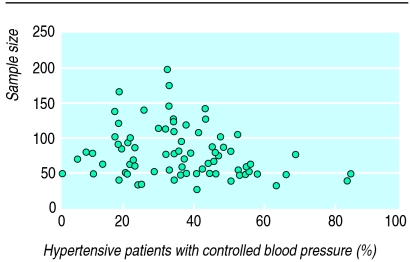Editor—McColl et al provide a welcome alternative1 to performance indicators proposed by the NHS Executive and the Department of Health.2 They have suggested a range of evidence based interventions which are likely to produce behaviour change at practice level. The proposed indicators are very different from the performance indicators in current use, which seem to have a political role at health authority level, often being used simply to search for poorly performing doctors.
I have looked at the performance indicators that have been described in the literature, and in particular the scientific evidence underpinning them. Little evidence exists for the validity of using the common indicators in current use.3 A consistent finding is that indicators are often chosen for their ease of collection rather than their scientific validity. The most commonly used indicators include uptake of cervical cytology, immunisation rates, and various prescribing indicators. I have found little published research showing the importance of a high or low indicator. This applies particularly when the indicators have been accepted as proxy measures of individual general practitioners’ clinical competence. Others have also reviewed performance indicators and have identified additional areas that raise doubts about their validity.4,5
The new indicators will need to be differentiated from the non-clinical indicators that are currently popular markers of clinical competence. In practice these often reflect historic support that has been provided for the practice rather than the competence of the individual general practitioner. Thus the proposed introduction of evidence based clinical indicators for primary care groups provides a more acceptable way forward.
Although McColl et al’s paper refers to cost effectiveness of proposed interventions, the likely timescale over which they will operate requires consideration, as it has an important implication for the primary care groups at which they are targeted. Although secondary and tertiary prevention may reduce morbidity and mortality over decades, the short term effects of the implementation of interventions will create upward pressure on costs, particularly prescribing costs. This issue should not present obstacles to the promotion of evidence based interventions at the level of primary care groups but must be taken into account when these groups and health authorities are funding health improvement plans.
References
- 1.McColl A, Roderick P, Gabbay J, Smith H, Moore M. Performance indicators for primary care groups: an evidence based approach. BMJ. 1998;317:1354–1360. doi: 10.1136/bmj.317.7169.1354. . (14 November.) [DOI] [PMC free article] [PubMed] [Google Scholar]
- 2.NHS Executive. The new NHS: modern and dependable. A national framework for assessing performance. London: Department of Health; 1998. [Google Scholar]
- 3.Myers P. Are current performance indicators helpful in the identification of poorly performing GPs? Departmental report. London: Queen Mary and Westfield College; 1998. [Google Scholar]
- 4.Majeed FA, Voss S. Performance indicators for general practice. BMJ. 1995;311:209–210. doi: 10.1136/bmj.311.6999.209. [DOI] [PMC free article] [PubMed] [Google Scholar]
- 5.Aveyard P. Monitoring the performance of general practices. J Eval Clin Pract. 1997;3:275–281. doi: 10.1046/j.1365-2753.1997.t01-1-00004.x. [DOI] [PubMed] [Google Scholar]



